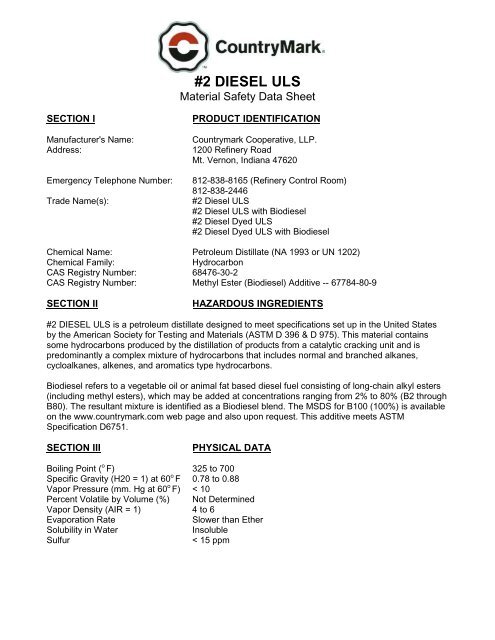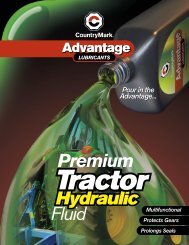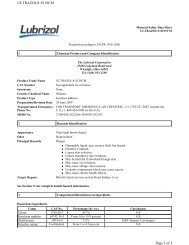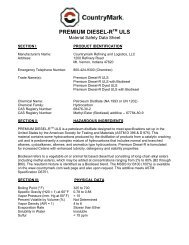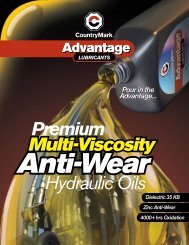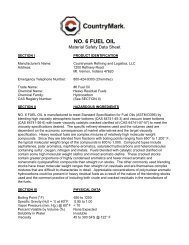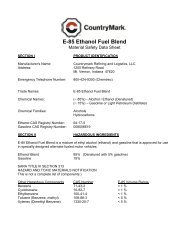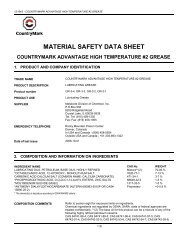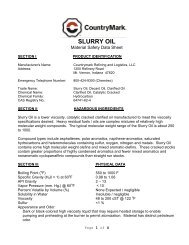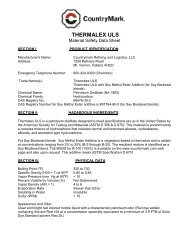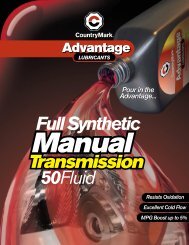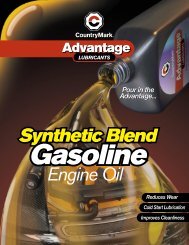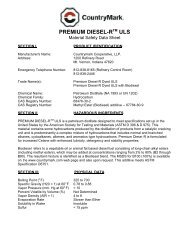#2 Diesel ULS - 0610 - CountryMark
#2 Diesel ULS - 0610 - CountryMark
#2 Diesel ULS - 0610 - CountryMark
Create successful ePaper yourself
Turn your PDF publications into a flip-book with our unique Google optimized e-Paper software.
<strong>#2</strong> DIESEL <strong>ULS</strong><br />
Material Safety Data Sheet<br />
SECTION I<br />
Manufacturer's Name:<br />
Address:<br />
Emergency Telephone Number:<br />
Trade Name(s):<br />
Chemical Name:<br />
Chemical Family:<br />
CAS Registry Number:<br />
CAS Registry Number:<br />
SECTION II<br />
PRODUCT IDENTIFICATION<br />
Countrymark Cooperative, LLP.<br />
1200 Refinery Road<br />
Mt. Vernon, Indiana 47620<br />
812-838-8165 (Refinery Control Room)<br />
812-838-2446<br />
<strong>#2</strong> <strong>Diesel</strong> <strong>ULS</strong><br />
<strong>#2</strong> <strong>Diesel</strong> <strong>ULS</strong> with Biodiesel<br />
<strong>#2</strong> <strong>Diesel</strong> Dyed <strong>ULS</strong><br />
<strong>#2</strong> <strong>Diesel</strong> Dyed <strong>ULS</strong> with Biodiesel<br />
Petroleum Distillate (NA 1993 or UN 1202)<br />
Hydrocarbon<br />
68476-30-2<br />
Methyl Ester (Biodiesel) Additive -- 67784-80-9<br />
HAZARDOUS INGREDIENTS<br />
<strong>#2</strong> DIESEL <strong>ULS</strong> is a petroleum distillate designed to meet specifications set up in the United States<br />
by the American Society for Testing and Materials (ASTM D 396 & D 975). This material contains<br />
some hydrocarbons produced by the distillation of products from a catalytic cracking unit and is<br />
predominantly a complex mixture of hydrocarbons that includes normal and branched alkanes,<br />
cycloalkanes, alkenes, and aromatics type hydrocarbons.<br />
Biodiesel refers to a vegetable oil or animal fat based diesel fuel consisting of long-chain alkyl esters<br />
(including methyl esters), which may be added at concentrations ranging from 2% to 80% (B2 through<br />
B80). The resultant mixture is identified as a Biodiesel iesel blend. The MSDS for B100 (100%) is available<br />
on the www.countrymark.com web page and also upon request. This additive meets ASTM<br />
Specification D6751.<br />
SECTION III<br />
Boiling Point ( o F)<br />
Specific Gravity (H20 = 1) at 60 o F<br />
Vapor Pressure (mm. Hg at 60 o F)<br />
Percent Volatile by Volume (%)<br />
Vapor Density (AIR = 1)<br />
Evaporation Rate<br />
Solubility in Water<br />
Sulfur<br />
PHYSICAL DATA<br />
325 to 700<br />
0.78 to 0.88<br />
< 10<br />
Not Determined<br />
4 to 6<br />
Slower than Ether<br />
Insoluble<br />
< 15 ppm
Material Safety Data Sheet<br />
<strong>#2</strong> <strong>Diesel</strong> <strong>ULS</strong><br />
Page 2 of 4<br />
Appearance and Odor:<br />
Clear to light yellow colored mobile liquid with a characteristic petroleum odor. <strong>#2</strong> <strong>Diesel</strong> Dyed <strong>ULS</strong> is<br />
a dyed product. It’s appearance is clear and red colored mobile liquid with characteristic petroleum<br />
odor (Red dye added containing Solvent Red 164 at a concentration spectrally equivalent to a<br />
minimum of 3.9 PTB of solid dye standard solvent Red 26).<br />
SECTION IV<br />
FIRE AND EXPLOSION HAZARD DATA<br />
Flash Point (PM):<br />
> 125° F<br />
Classification: Flammable Liquid UN 1993<br />
Flammable Limits: LEL 0.6 UEL 8.0__<br />
Explosive Limits: Lower to 1.0 %<br />
HMIS H=1 F=2 R=0 PPE=B<br />
NFPA Red=2 Blue=1 Yellow=0 White=n/a<br />
Extinguishing Media:<br />
Small Fires: Dry Chemical, Carbon Dioxide, Water Spray, or Foam<br />
Large Fires: Water Spray, Fog, or Foam<br />
Hazardous Decomposition Products:<br />
May form toxic materials of carbon dioxide and carbon monoxide, various hydrocarbons, etc.<br />
as combustion byproducts.<br />
Special Fire Fighting Procedures:<br />
Cool containers with water spray to prevent re-ignition. Containers may explode in heat of fire.<br />
Use unmanned fixed nozzles where possible.<br />
Unusual Fire and Explosion Hazards:<br />
Can react violently with oxidizing agents such as Chlorine, Permanganates, and Dichromates<br />
resulting in fire or explosion. Never use welding or cutting torch on or near container (even<br />
empty) because product (even just residue) can ignite explosively.<br />
SECTION V<br />
HEALTH HAZARD<br />
Threshold Limit Value:<br />
300 to 500 PPM if essentially Aliphatic Hydrocarbon composition. When benzene and or other<br />
aromatics are present, then about 120 PPM TLV is applicable.<br />
Effects of Overexposure:<br />
EYES - Can cause severe irritation, redness, tearing, blurred vision.<br />
SKIN - Prolonged or repeated contact can cause moderate irritation, defatting or dermatitis.<br />
BREATHING - Excessive inhalation of vapors can cause nasal irritation, dizziness, weakness,<br />
fatigue, nausea, headache, possible unconsciousness, and even asphyxiation.<br />
SWALLOWING - Can cause gastrointestinal irritation, nausea, vomiting, diarrhea. Aspiration of<br />
material into the lungs can cause chemical pneumonia.<br />
Emergency and First Aid Procedures:<br />
IF IN EYES - Flush with large amounts of water, lifting upper and lower lids occasionally. Get<br />
medical attention.<br />
IF ON SKIN - Thoroughly wash exposed area with soap and water. Remove contaminated<br />
clothing. Launder contaminated clothing before wearing.<br />
IF INHALED - Remove individual to fresh air. If breathing is difficult, administer oxygen. If<br />
breathing has stopped, give artificial respiration. Keep person warm, quiet, and get medical<br />
attention.
Material Safety Data Sheet<br />
<strong>#2</strong> <strong>Diesel</strong> <strong>ULS</strong><br />
Page 3 of 4<br />
IF SWALLOWED - Do not induce vomiting. Keep person warm, quiet and get medical<br />
attention. Aspiration of material into the lungs due to vomiting can cause chemical<br />
pneumonia which can be fatal.<br />
SECTION VI<br />
REACTIVITY DATA<br />
Stable _X Unstable _____<br />
Incompatability (Materials to avoid): Avoid contact with strong oxidizing agents like Chlorine,<br />
Permanganates, and Dichromates as these may cause fire/explosion.<br />
Hazardous Decomposition Products:<br />
May form toxic materials of Carbon Dioxide and Carbon Monoxide, various hydrocarbons, etc.<br />
as combustion by- products.<br />
Hazardous Polymerization: May Occur _____ Will Not Occur __X__<br />
SECTION VII<br />
SPILL OR LEAK PROCEDURES<br />
Steps to be taken in case material is released:<br />
Small Spill: Eliminate all ignition sources (smoking, flares, flames, including pilot lights, electrical<br />
sparks, and etc.). Absorb liquid on paper, vermiculite, floor absorbent, or other absorbent<br />
material and transfer to non-leaking containers for proper disposal.<br />
Large Spill: Eliminate all ignition sources (smoking, flares, flames, including pilot lights, electrical<br />
sparks, and etc.). Persons not wearing protective equipment should be excluded from area of<br />
spill until clean-up has been completed. Stop spill at source, dike area of spill to prevent<br />
spreading, pump liquid to salvage tank or truck. Remaining liquid may be taken up on sand,<br />
clay, earth, floor absorbent or other absorbent material and shoveled into non-leaking<br />
containers for proper disposal. Prevent run-off to sewers, streams or other bodies of water. If<br />
run-off occurs, notify proper authorities as required.<br />
Waste Disposal Method:<br />
Small Spill: Absorb in suitable media or allow volatile portion to evaporate if allowed under law. Allow<br />
sufficient time for vapors to completely clear.<br />
Large Spill: Reclaim as much as possible for reprocessing or salvage. Destroy by liquid incineration.<br />
Contaminated absorbent may be deposited in a landfill in accordance with local, state and<br />
federal regulations.<br />
SECTION VIII<br />
SPECIAL PROTECTION INFORMATION<br />
Respiratory Protection:<br />
Normally not needed for normal exposure. A NIOSH/MSHA approved air supplied respirator is<br />
advised in absence of proper environmental control. Firefighters may require SCBA Positive<br />
Pressure Breathing Apparatus when involved in petroleum fires.<br />
Ventilation:<br />
Explosion proof motors and fans are required to provide sufficient mechanical (general and/or<br />
local exhaust) ventilation to maintain exposure below TLV(S). Mixture of vapors and air is<br />
highly explosive if ignited.<br />
Personal Protective Equipment and Apparel:<br />
Gloves: Wear petroleum resistant gloves such as: Neoprene, Nitrile, rubber gloves, etc.<br />
Eye Protection: Safety goggles or face shield for protection from splashing in eyes.
Material Safety Data Sheet<br />
<strong>#2</strong> <strong>Diesel</strong> <strong>ULS</strong><br />
Page 4 of 4<br />
Other Protective Equipment: Wear impervious protective clothing and boots appropriate for<br />
work situations to prevent repeated or prolonged skin contact. Launder contaminated<br />
clothing before wearing.<br />
SECTION IX<br />
SPECIAL PRECAUTIONS<br />
Precautions to be taken when handling and storing:<br />
Keep all containers in upright position. Store in a cool, dry, well ventilated area away from<br />
heat, ignition, and strong oxidizers. Do not allow smoking in areas of use or dispensing.<br />
Motors, fans, switches, and etc. in area of use or dispensing should be explosion proof.<br />
Ground containers when filling. Prevent all static and electric sparks.<br />
Other Precautions:<br />
Have written confined space and tank entry procedures. Never allow tank entry without<br />
checking OXYGEN AND VAPOR levels. Use safety harness and safety line on person<br />
entering a tank. Stand-by person required with protective equipment available.<br />
SECTION X<br />
TOXICOLOGICAL INFORMATION<br />
No applicable information was found.<br />
SECTION XI<br />
DOT LABELING INFORMATION<br />
Proper Shipping Name:<br />
<strong>#2</strong> DIESEL <strong>ULS</strong> (or other applicable trade name)<br />
Hazardous Classification: <strong>Diesel</strong> Fuel, 3, NA 1993 or UN 1202, PG III (DOT ERG No. 128)<br />
Identification Number: NA 1993 or UN 1202<br />
Label(s) Required:<br />
Flammable Liquid<br />
DISCLAIMER OF LIABILITY<br />
The information in this MSDS was obtained from sources which we believe are reliable; however, the<br />
information is provided without any warranty, expressed or implied, regarding its correctness.<br />
The conditions or methods of handling, storage, use and disposal of this product are beyond our<br />
control and may be beyond our knowledge. For this and other reasons, we do not assume<br />
responsibility and expressly disclaim liability for loss, damage or expense arising out of or in any way<br />
connected with the handling, storage, use or disposal of this product.<br />
This MSDS was prepared and is to be used only for this product. If this product is used as a<br />
component in another product or mixed with another product, this MSDS information may not be<br />
applicable.<br />
Date of Preparation or Last Change: June 2010


